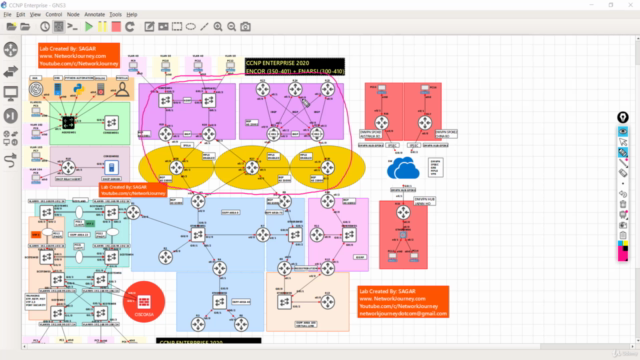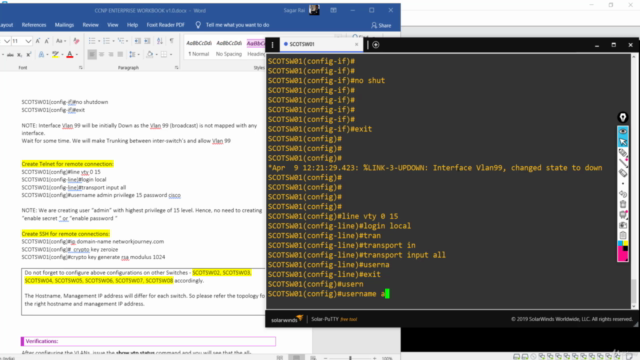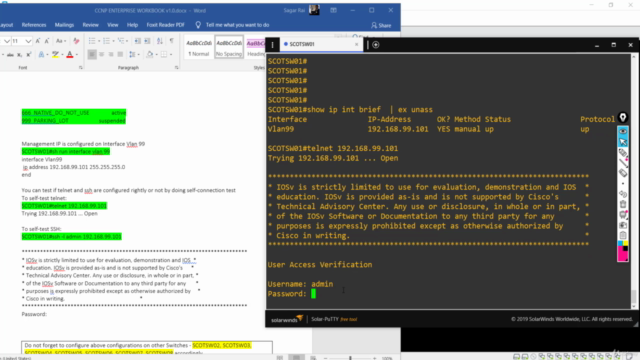CCNP ENTERPRISE {2025} ENCOR+ENARSI | 120+ Hr NetworkJourney

Why take this course?
-
Troubleshoot OSPF (v2/v3):
a. Address families (IPv4, IPv6): OSPF can operate in both IPv4 and IPv6 environments. You need to understand how to configure and troubleshoot OSPF for each address family separately.
b. Neighbor relationship and authentication: Establishing neighbor relationships is crucial for OSPF to function correctly. You must know how to verify Neighbor state, priorities, cost, and authentication type (simple password, MD5, or null).
c. Network types, area types, and router types:
- Point-to-point and multipoint: Understand the difference between point-to-point and multipoint subnets and how to configure them.
- Broadcast and nonbroadcast: Know when to use broadcast or nonbroadcast networks and their configurations.
- Area type: Understand the different area types (backbone, normal, transit, stub, Not-So-Stubby Area - NSSA, totally stub) and how they affect OSPF operation.
- Router types: Internal router, backbone router, Area Border Router (ABR), and Autonomous System Boundary Router (ASBR).
d. Virtual link: A Cisco-specific feature used to connect two OSPF areas when there is no other way to route traffic between them. It's useful in scenarios where the underlying physical network topology prevents areas from being directly connected.
e. Path preference: Understand how OSPF calculates path costs, path selection, and what affects path preference (e.g., cost, bandwidth, delay, MTU).
-
Troubleshoot BGP (Internal and External):
a. Address families (IPv4, IPv6): BGP can operate with both IPv4 and IPv6, and you need to troubleshoot issues in either context.
b. Neighbor relationship and authentication: Establishing peering relationships with neighbors is fundamental. You must verify neighbor states, authentication methods (including MD5 and resource public key infrastructure - RPKI), and synchronization status.
c. Path preference (attributes and best-path): Understand the attributes that influence BGP path selection and how to configure weight, local preference, and MED to influence route choice.
d. Route reflector (RFC 5575): Know how to implement a route reflector to optimize routing table growth and reduce the number of iBGP peer relationships.
e. Policies (inbound/outbound filtering, path manipulation): Be able to configure route maps or distribute lists to apply policies for both inbound and outbound traffic.
-
VPN Technologies:
a. Describe MPLS operations: Understand Label Switching Path Protocol (LSP), Label Distribution Protocol (LDP), label stacking, and how labels are used to forward packets in an MPLS network.
b. Describe MPLS Layer 3 VPN: Understand how Layer 3 VPNs use MPLS labels to provide IP routing between sites over a shared MPLS network while maintaining the privacy and segregation of customer networks.
c. Configure and verify DMVPN (single hub): A Cisco proprietary technology that combines GRE, Mobile VPN, and LDP for secure site-to-site and site-to-user connectivity without the need for preconfigured tunnels.
- GRE/mGRE: Encapsulation protocol used in DMVPN to create tunnels.
- NHRP: Locator/ID Separation Protocol (LISP) alternative used by DMVPN for host reachability.
- LDP or Auto-LDP: Used for label distribution in MPLS networks.
-
Troubleshoot IPv4 and IPv6 DHCP:
a. DHCP client configuration: Understand how to configure a device to obtain an IP address, default gateway, and DNS server addresses via DHCP.
b. IOS DHCP server configuration: Set up a Cisco router as a DHCP server to provide IP addresses, options, and other configuration details to clients.
c. DHCP relay: Configure routers to relay DHCP requests from subnets where the clients are located to the central DHCP server.
d. DHCP options: Understand the various DHCP options and how to configure them, including vendor-specific options.
-
Troubleshoot network performance issues using IP SLA:
a. IP SLA: Understand how to configure and use IP SLA to measure performance of networks (latency, jitter, packet loss, etc.) and create Service Level Agreements (SLAs).
-
Troubleshoot NetFlow (v5, v9, flexible NetFlow):
a. NetFlow: Understand the basics of NetFlow and how it can be used to monitor network traffic. NetFlow version 5 and 9 have different capabilities, with version 9 offering more detailed data on IP traffic.
b. Flexible NetFlow: A Cisco-specific feature that allows for greater customization and flexibility in monitoring network traffic than standard versions of NetFlow.
-
Troubleshoot with Cisco DNA Center assurance:
a. Connectivity: Verify device connectivity, check interface status, and ensure devices are properly connected to the network.
b. Monitoring: Keep track of performance metrics, historical data, and trends for both wired and wireless networks.
c. Device health: Monitor the operational health and status of devices within your network, including alerts for potential issues.
d. Network health: Understand the overall health of the network, including service impacting events or potential vulnerabilities that may affect the network's performance.
Remember that troubleshooting involves not only configuring and verifying each component but also understanding how these components interact with each other within the broader context of the network. Effective troubleshooting requires a systematic approach, attention to detail, and sometimes a deep dive into the technical specifications of protocols and technologies.
Course Gallery




Loading charts...